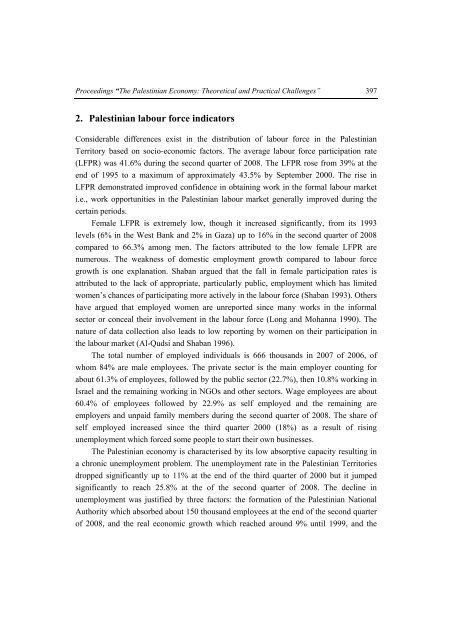The Palestinian Economy. Theoretical and Practical Challenges
The Palestinian Economy. Theoretical and Practical Challenges
The Palestinian Economy. Theoretical and Practical Challenges
Create successful ePaper yourself
Turn your PDF publications into a flip-book with our unique Google optimized e-Paper software.
Proceedings “<strong>The</strong> <strong>Palestinian</strong> <strong>Economy</strong>: <strong>The</strong>oretical <strong>and</strong> <strong>Practical</strong> <strong>Challenges</strong>” 397<br />
2. <strong>Palestinian</strong> labour force indicators<br />
Considerable differences exist in the distribution of labour force in the <strong>Palestinian</strong><br />
Territory based on socio-economic factors. <strong>The</strong> average labour force participation rate<br />
(LFPR) was 41.6% during the second quarter of 2008. <strong>The</strong> LFPR rose from 39% at the<br />
end of 1995 to a maximum of approximately 43.5% by September 2000. <strong>The</strong> rise in<br />
LFPR demonstrated improved confidence in obtaining work in the formal labour market<br />
i.e., work opportunities in the <strong>Palestinian</strong> labour market generally improved during the<br />
certain periods.<br />
Female LFPR is extremely low, though it increased significantly, from its 1993<br />
levels (6% in the West Bank <strong>and</strong> 2% in Gaza) up to 16% in the second quarter of 2008<br />
compared to 66.3% among men. <strong>The</strong> factors attributed to the low female LFPR are<br />
numerous. <strong>The</strong> weakness of domestic employment growth compared to labour force<br />
growth is one explanation. Shaban argued that the fall in female participation rates is<br />
attributed to the lack of appropriate, particularly public, employment which has limited<br />
women’s chances of participating more actively in the labour force (Shaban 1993). Others<br />
have argued that employed women are unreported since many works in the informal<br />
sector or conceal their involvement in the labour force (Long <strong>and</strong> Mohanna 1990). <strong>The</strong><br />
nature of data collection also leads to low reporting by women on their participation in<br />
the labour market (Al-Qudsi <strong>and</strong> Shaban 1996).<br />
<strong>The</strong> total number of employed individuals is 666 thous<strong>and</strong>s in 2007 of 2006, of<br />
whom 84% are male employees. <strong>The</strong> private sector is the main employer counting for<br />
about 61.3% of employees, followed by the public sector (22.7%), then 10.8% working in<br />
Israel <strong>and</strong> the remaining working in NGOs <strong>and</strong> other sectors. Wage employees are about<br />
60.4% of employees followed by 22.9% as self employed <strong>and</strong> the remaining are<br />
employers <strong>and</strong> unpaid family members during the second quarter of 2008. <strong>The</strong> share of<br />
self employed increased since the third quarter 2000 (18%) as a result of rising<br />
unemployment which forced some people to start their own businesses.<br />
<strong>The</strong> <strong>Palestinian</strong> economy is characterised by its low absorptive capacity resulting in<br />
a chronic unemployment problem. <strong>The</strong> unemployment rate in the <strong>Palestinian</strong> Territories<br />
dropped significantly up to 11% at the end of the third quarter of 2000 but it jumped<br />
significantly to reach 25.8% at the of the second quarter of 2008. <strong>The</strong> decline in<br />
unemployment was justified by three factors: the formation of the <strong>Palestinian</strong> National<br />
Authority which absorbed about 150 thous<strong>and</strong> employees at the end of the second quarter<br />
of 2008, <strong>and</strong> the real economic growth which reached around 9% until 1999, <strong>and</strong> the
















